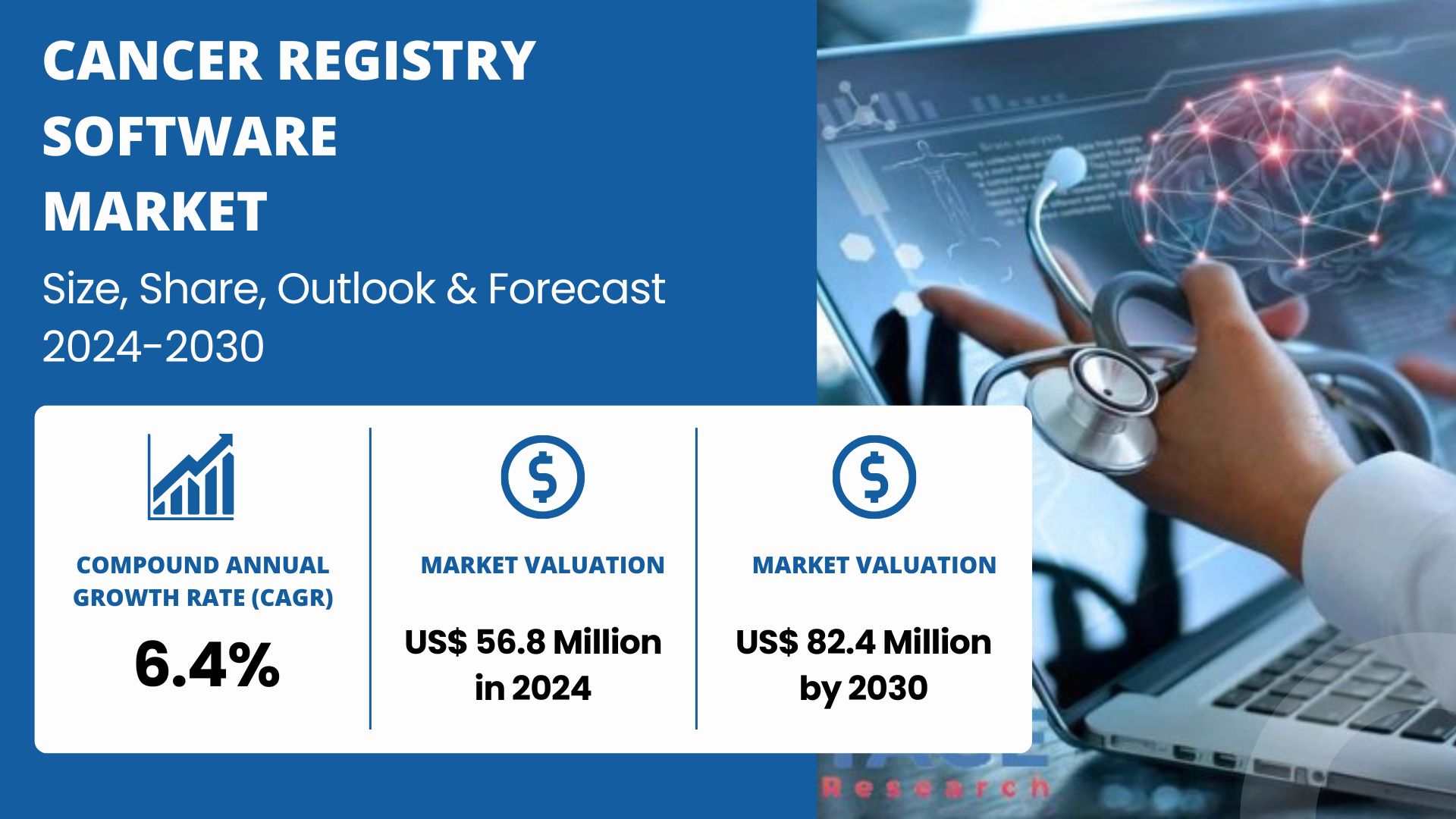TOP CATEGORY: Chemicals & Materials | Life Sciences | Banking & Finance | ICT Media

Download Report PDF Instantly
Report overview
The "Global Cancer Registry Software Market" size was valued at US$ 56.8 million in 2024 and is projected to reach US$ 82.4 million by 2030, at a CAGR of 6.4% during the forecast period 2024-2030.
"United States Cancer Registry Software Market" size was valued at US$ 15.5 million in 2024 and is projected to reach US$ 22.0 million by 2030, at a CAGR of 6.0% during the forecast period 2024-2030.
Cancer Registry Software is a specialized tool designed to assist healthcare facilities and organizations in collecting, managing, and analyzing data related to cancer patients. This software supports the creation and maintenance of cancer registries, which are comprehensive databases that compile information on cancer cases, treatments, outcomes, and epidemiological trends. The primary goal of cancer registry software is to enhance patient care, support research, and facilitate public health initiatives.
Here are the key features and points of Cancer Registry Software:
Data Collection and Management: Facilitates the systematic collection of patient data, including demographics, tumor characteristics, treatment details, and follow-up outcomes.
Standardized Data Entry: Utilizes standardized formats and coding systems (e.g., ICD, AJCC) to ensure consistency and accuracy in data entry, making it easier to analyze and compare data.
Patient Tracking: Provides tools for tracking cancer patients throughout their treatment and recovery, ensuring that all relevant information is captured and maintained over time.
Reporting and Analytics: Generates comprehensive reports and analytics to support clinical decision-making, research studies, and compliance with regulatory requirements.
Integration with Electronic Health Records (EHRs): Integrates with EHR systems to streamline data entry and enhance data accuracy by pulling relevant information from patient records.
Compliance with Regulations: Ensures compliance with local, regional, and national cancer reporting requirements, including data submission to cancer surveillance programs and health authorities.
User Access Control: Allows for customizable user access levels to ensure data security while providing relevant stakeholders access to necessary information.
Data Quality Assurance: Implements validation checks and data quality measures to ensure the accuracy and completeness of the information recorded in the registry.
Case Follow-Up Management: Provides tools for scheduling follow-ups and managing case updates to maintain accurate and current patient information.
Clinical Trial Tracking: Facilitates the tracking of patients participating in clinical trials, allowing for easier management of research data and outcomes.
Geographic Information Systems (GIS): Some software includes GIS capabilities to analyze cancer incidence and outcomes geographically, aiding public health assessments and initiatives.
Customizable Dashboards: Offers customizable dashboards for visualizing key performance indicators, trends, and patient demographics, enabling quick insights for healthcare providers and researchers.
Data Export and Interoperability: Allows for data export in various formats for use in research, public health reporting, and other applications, promoting interoperability with other systems.
Support for Research and Epidemiology: Provides researchers with access to a rich database for conducting epidemiological studies, identifying trends, and improving cancer prevention and treatment strategies.
Cancer Registry Software is crucial for improving cancer care, advancing research, and supporting public health efforts by providing reliable and comprehensive data on cancer incidence, treatment, and outcomes.

Report Overview
Cancer Registry Software is a suite of software programs for collecting and processing cancer registry data.
This report provides a deep insight into the global Cancer Registry Software market covering all its essential aspects. This ranges from a macro overview of the market to micro details of the market size, competitive landscape, development trend, niche market, key market drivers and challenges, SWOT analysis, value chain analysis, etc.
The analysis helps the reader to shape the competition within the industries and strategies for the competitive environment to enhance the potential profit. Furthermore, it provides a simple framework for evaluating and accessing the position of the business organization. The report structure also focuses on the competitive landscape of the Global Cancer Registry Software Market, this report introduces in detail the market share, market performance, product situation, operation situation, etc. of the main players, which helps the readers in the industry to identify the main competitors and deeply understand the competition pattern of the market.
In a word, this report is a must-read for industry players, investors, researchers, consultants, business strategists, and all those who have any kind of stake or are planning to foray into the Cancer Registry Software market in any manner.
Global Cancer Registry Software Market: Market Segmentation Analysis
The research report includes specific segments by region (country), manufacturers, Type, and Application. Market segmentation creates subsets of a market based on product type, end-user or application, Geographic, and other factors. By understanding the market segments, the decision-maker can leverage this targeting in the product, sales, and marketing strategies. Market segments can power your product development cycles by informing how you create product offerings for different segments.
Key Company
By Type
By Application
Geographic Segmentation
Key Benefits of This Market Research:
Key Reasons to Buy this Report:
Chapter Outline
Chapter 1 mainly introduces the statistical scope of the report, market division standards, and market research methods.
Chapter 2 is an executive summary of different market segments (by region, product type, application, etc), including the market size of each market segment, future development potential, and so on. It offers a high-level view of the current state of the Cancer Registry Software Market and its likely evolution in the short to mid-term, and long term.
Chapter 3 makes a detailed analysis of the market's competitive landscape of the market and provides the market share, capacity, output, price, latest development plan, merger, and acquisition information of the main manufacturers in the market.
Chapter 4 is the analysis of the whole market industrial chain, including the upstream and downstream of the industry, as well as Porter's five forces analysis.
Chapter 5 introduces the latest developments of the market, the driving factors and restrictive factors of the market, the challenges and risks faced by manufacturers in the industry, and the analysis of relevant policies in the industry.
Chapter 6 provides the analysis of various market segments according to product types, covering the market size and development potential of each market segment, to help readers find the blue ocean market in different market segments.
Chapter 7 provides the analysis of various market segments according to application, covering the market size and development potential of each market segment, to help readers find the blue ocean market in different downstream markets.
Chapter 8 provides a quantitative analysis of the market size and development potential of each region and its main countries and introduces the market development, future development prospects, market space, and capacity of each country in the world.
Chapter 9 introduces the basic situation of the main companies in the market in detail, including product sales revenue, sales volume, price, gross profit margin, market share, product introduction, recent development, etc.
Chapter 10 provides a quantitative analysis of the market size and development potential of each region in the next five years.
Chapter 11 provides a quantitative analysis of the market size and development potential of each market segment (product type and application) in the next five years.
Chapter 12 is the main points and conclusions of the report.
Customization of the Report
In case of any queries or customization requirements, please connect with our sales team, who will ensure that your requirements are met.